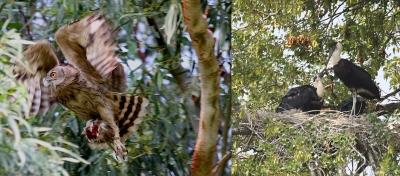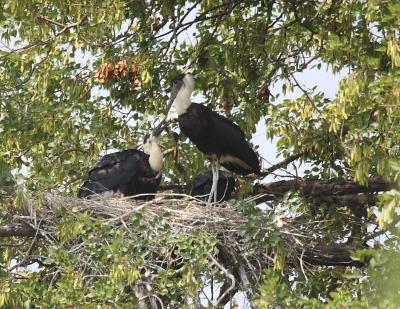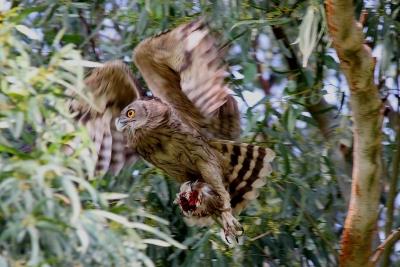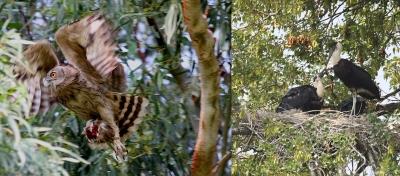
As storks make nests for owls, scientists gain green wisdom



By Vishal Gulati
Chandigarh, April 3 (IANS) In the farmlands of southern Haryana, a pair of woolly-necked storks get ready to leave their nest along with their chicks who had just started flying.
The large ungainly stick nest of the storks was still surprisingly intact after three months of use. The nest, however, was not left empty for long after the storks left. A pair of large dusky eagle owls took over almost immediately. And raised their chicks in the same nest.
In itself, this occurrence of a large owl reusing a large nest was not entirely remarkable.
Most large owls do not build their own nests, instead using natural features such as cliffs or nests built by other birds to breed on.
The remarkable elements of the waterbird-large raptor story played out as researchers of the Nature Conservation Foundation watched hundreds of stork nests for over nearly a decade.
Woolly-necked storks have a thriving population in Haryana's farmlands. This defies conventional assumptions. This stork species was wrongly assumed to need protected forests and wetlands to breed.
While studying these storks, researchers noticed the large dusky eagle owls reusing the nests after the storks had completed their breeding. They began to carefully piece together an inter-species association that had never been documented before.
Explaining the stork-owl bond, Gopi Sundar, the lead scientist of the project, told IANS that most of the owls' reused nests were in areas that had more woolly-necked storks nesting.
The owls did reuse large nests of other birds such as eagles and ibises in the same area but did so very rarely. The entire goings-on were very unusual since it suggested that the owl was tracking the storks' breeding rather than use any old nest that it encountered.
This was the first time anyone had discovered a large predatory bird being reliant on nests built by one species.
Such a relationship where one species, in this case the owl, relied on the resources created by another species, the nests of the stork, without harming the species is called commensalism.
This study documented the first instance of commensalism involving a large owl and a large waterbird anywhere. The research was recently published in the international journal 'Biotropica' that accepts original research on species in tropical ecosystems.
The authors of this research paper include Rakesh Ahlawat and Devender Singh Dalal who were field associates on the project.
In India, it is very unusual for field associates to be included as full co-authors of scientific papers published in international journals.
Scientists usually relegate their field staff to the acknowledgements.
Sundar, and his colleague Swati Kittur, carried out the mapping and analyses for this work.
The scientists noted other fascinating aspects during the study.
Woolly-necked storks made their nests largely on the very common tree, sheesham or Dalbergia sissoo. Sheesham is a native tree species treasured by farmers and villagers for its hard wood being used even to make yokes for farming and for furniture.
The storks also made many nests on the large Peepal (Ficus religiosa) trees that were revered in local Hindu culture.
The third tree species that storks liked to nest on was the exotic safeda (Eucalyptus sp.) that has been imported from Australia.
Sundar and his team noticed that the dusky eagle owls, though relying on nests made by storks, largely preferred stork nests made on Eucalyptus and not on Sheesham.
This was evidence that a secondary nest user exercised its own choice when deciding which stork nests to reuse.
The owls were commensal but were being picky about which tree they liked and were not content just mimicking the preferences of the storks.
These observations provide the first ever scientific information on the habits of the dusky eagle owl, which is among the least studied birds in the world.
Relationships such as commensalism require two species to get used to each other's habits, usually over very long periods of time.
Most inter-species interactions have been discovered in protected forests. In the case of Haryana's storks and owls, this discovery of commensalism was in an agricultural area.
Agriculture in Jhajjar and Rohtak districts, where this study was conducted, was not new and has been in practice for centuries.
Farmers here have conventionally planted trees along with crops such as corn and wheat. This mixed system of cultivation appears to have been around long enough to have allowed two very different species to interact and develop a commensal relationship.
In India, most ecological research is focused on species inside forested areas and protected reserves. This new research shows that traditional agricultural areas of the country appear to provide stable conditions that allow the development of interesting inter-species interactions and relationships.
Do other traditional agricultural landscapes of India have other species interacting similarly?
A lot more research is needed with researchers fanning out across the diverse agricultural areas of the country to answer this broad question, says Sundar.
Storks are famously thought to bring home babies in Europe and are revered in many cultures the world over.
Sundar, who is also the Co-chair of the IUCN Stork, Ibis and Spoonbill Specialist Group, told IANS, 'Our country can boast of storks bringing home a large and lovely owl, with due thanks to the humble farmer whose way of life supports so much more than just human families'.
Development activities around Delhi in the larger NCR promise to be challenges to both traditional agriculture and species such as the woolly-necked storks and dusky eagle owls.
Sundar believes authorities urgently need to revise models of development to incorporate traditional activities such as multifunctional agriculture that can, in turn, greatly benefit several wild and fascinating species.
(Vishal Gulati can be contacted at )
--IANS
vg/bg

Legal Disclaimer:
MENAFN provides the
information “as is” without warranty of any kind. We do not accept
any responsibility or liability for the accuracy, content, images,
videos, licenses, completeness, legality, or reliability of the information
contained in this article. If you have any complaints or copyright
issues related to this article, kindly contact the provider above.


















Comments
No comment